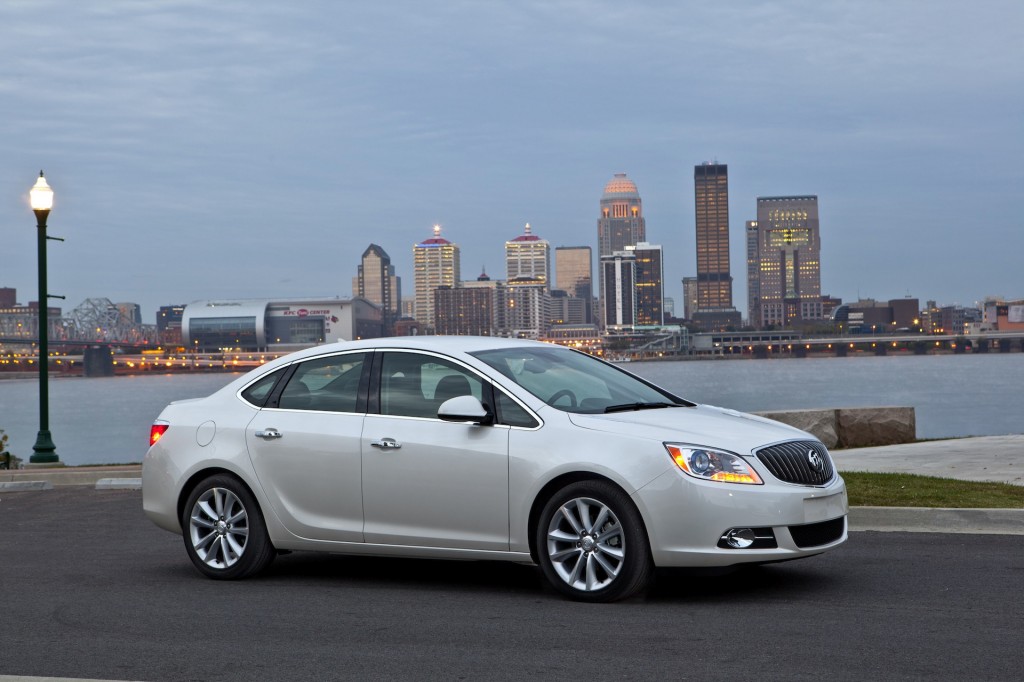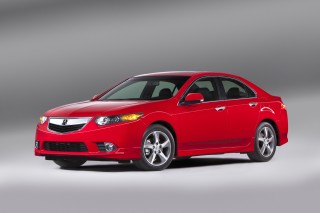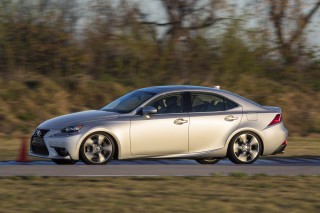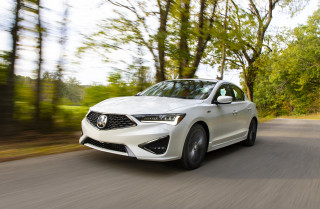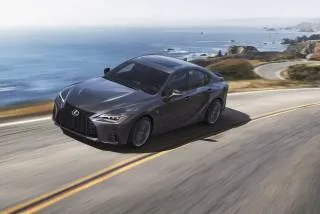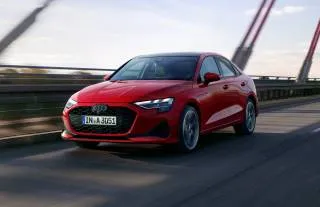Likes
- Composed and quiet beyond its class
- Luxurious interior
- Very good ride quality
- Connectivity and safety are up to speed
- Base price is a bargain
Dislikes
- Base Verano isn't quick
- Ventiports....no. Just, no.
- Fuel economy's relatively low
- Cozy rear seats are cozy
Buying tip
features & specs
Mild or slightly spicy--in either flavor, the 2014 Buick Verano delivers long on comfort, without bowing to sport-sedan cliches.
The Verano has been a timely addition to the Buick lineup. Just as true luxury brands like Mercedes-Benz and Audi are getting into the compact act, Buick's already fielded an entry that's arguably richer in feel and quieter on the road.
Layered with premium features and a refined attitude that belies its middle-market pricetag, the Verano carries over almost unchanged into the 2014 model year. From a styling point of view, that's fine--the Verano fits neatly in the Buick spectrum, with just enough hints of its heritage in the grille and interior to mask its small-car proportions. Almost all of its styling cues come across as tasteful and subdued, save for the hood's portholes. They're afterthoughts. The interior skips even that flaw: it really has its game together, with a nicely finished dash and gently lit gauges.
Interior furnishings are worthy of comparison to cars a price point above the Verano. The front-wheel drive layout grants the Verano a spacious interior. Front seats are superb, with all-day support for a wide range of drivers, along with plenty of seat travel and headroom for the tallest drivers. Rear seats are well contoured for adults, too; the only thing that calls the Verano out as a compact is the need to compromise legroom between front and rear if there are several lanky occupants riding at once. Trunk space is terrific and well-shaped with rear seatbacks that fold forward just about flat, with a wide lid opening.
The Verano is distinguished from less pricey compact four-doors by its quiet interior. Extensive measures to quell exterior sound go as far as triple-sealed rubber around the doors, laminated glass, an acoustic windshield, and numerous baffles, foams, and mats. The result? A sedan that is exceptionally quiet inside on even the coarsest surfaces.
Crash-test ratings from the NHTSA are five stars overall, but the Verano no longer rates as an IIHS Top Safety Pick, since it hasn't been subjected to the latest small-overlap crash test. Equipment-wise, it's all here: ten standard airbags, electronic stability control, and anti-lock braking with brake assist, as well as OnStar Automatic Crash Response. Backup parking assist is available, and a rearview camera is standard; Turbos have blind-spot monitors standard, too.
A 180-horsepower, 2.4-liter four-cylinder engine comes standard. It won't win drag races with its 0-60 mph sprint of 8.6 seconds, but this little sedan feels more eager than its numbers suggest thanks to the responsive feel of its 6-speed automatic and its high refinement level.
The 250-horsepower Turbo changes the Verano's mood considerably. It slices 2.5 seconds off of the base car's 0-60 time and there's little lag from the turbo or whistle from under the hood.
The Verano shares significant suspension and structure with the compact Chevrolet Cruze, but the Buick is more comfortably tuned and relentlessly quiet. Base cars have a softly sprung feel, and Turbos dial that to only slightly tauter settings. Handling? It's predictable, safe, and can even be fun if you don't mind ample body lean. The modestly faster steering and slightly firmer ride of the Turbo could easily be adapted to the base car, in our opinion. Disc brakes all around deliver good stopping power despite a spongy pedal feel.
Fuel efficiency isn't stellar for a small car. The Verano is rated by the EPA at 21/32 mpg, figures that don't exactly impress compared to the Cruze's 42 mpg highway number. The Verano does top non-hybrid small luxury-grade sedans, though, and the Turbo requires just a 1 mpg penalty (although it sips pricier premium unleaded).
The Verano is clearly not a Cadillac, but it's not priced as one either. Starting in the low $20,000s, the Verano comes equipped with an impressive roster of features, including dual-zone automatic climate control, steering-wheel controls, Bluetooth, a USB input, and the Buick IntelliLink touch-screen interface, which includes voice controls as well as Pandora and Stitcher apps. A Convenience Group incldues heated side mirrors, an auto-dimming rearview mirror, heated front seats, and rear parking assist, while a Leather Group adds a driver power seat, Bose surround sound audio, push-button keyless start, and premium leather upholstery. All that comes standard on the Turbo. A heated steering wheel and nav system are among the few options, with a fully loaded Verano priced well under $30,000, where the Turbo price begins.
2014 Buick Verano Styling
The appealing shape of the Buick Verano is paired with a high-quality, low-key interior.
The Buick Verano may be kin with the Chevy Cruze, but there's enough daylight between its more comely sheetmetal and the Cruze's relentlessly conservative lines to give the Buick breathing room.
The distinctions in exterior and interior styling tend to make the Verano look like a larger car than it is, or than the Cruze. It's all in some well-conceived details that underplay to the Verano's long roofline. The grille and headlamps are atypically small for GM as of late, but still cleanly faired into the Verano's sculpted nose. It's a handsome look that's just generic enough to woo new buyers to Buick.
It's not without some foibles. There's more bright metallic trim here than need be--it's a given these days, when even German cars are applying it in liberal doses. The bright veins that angle around the rear corners and angle downward toward the center in back are pretty and subtle. But those "ventiports?" The Verano's front fenders don't need them. Where's the delete button when you need it?
The Verano Turbo's subtle changes are dual exhaust outlets and a pert trunk spoiler. We wish that Buick would go just a little further to distinguish the zoomy version of its little car.
Inside, the look is radical and swoopy, with gorgeous two-tone themes and a tall sill that wraps from the top of the doors to where the windshield and the dashboard meet. The Verano's door cards carry through the dash's broad arcs. Matte metallic trim classes things up here and there and even the little windows at the front of the doors improve visibility.
2014 Buick Verano Performance
With turbo power the Verano is quick, but not sporty; most of its effort goes into being smooth and quiet.
The Buick Verano is one of the first compact cars to stake out premium territory here in the U.S., and given the nearly blank slate, Buick's chosen to tune it with comfort, not performance, in mind.
That said, the Verano is accommodating enough for most daily drivers, and its responsive electric power steering and well-sorted independent suspension pair well with its smooth four-cylinder engine. With turbocharging, it's truly quick but not much more taut; the mild re-tuning, frankly, could be applied across the board.
Instead of the related Cruze 1.4-liter four-cylinders, the Verano ups displacement under the hood to 2.4 liters. Its base four-cylinder turns in 180 horsepower and, through a six-speed automatic transmission, runs off an estimated 0-60 mph time of 8.6 seconds. That's slightly quicker than the Cruze can execute, and roughly on par with the other normally aspirated premium compact, the Acura ILX. In our tests, we've had to push the in-line four insistently through the lower rev range; it comes to life really only at about 4000 rpm.
The automatic isn't hesitant, but shifting it manually means putting a hand to the shift lever--the Verano isn't offered with shift paddles. Shifting manually is almost counterintuitive anyway--the Verano is so quiet, the engine always sounds distant, and the perceptions of speed always seem remote.
The Verano Turbo pitches a more solid game at the other turbocharged compact we've driven, the Mercedes CLA. With displacement shrunken to 2.0 liters and augmented with a blower, the Verano Turbo's boosted to 250 horsepower and peak torque of 260 pound-feet, available down at 1,700 rpm to a useful 5,500 rpm. There's hardly a growl or whistle to let on how it's spooling up to full boost, but the Verano Turbo can reel off 60-mph runs in 6.2 seconds or less. Top speed is limited by the tires to 129 mph, and fuel economy barely suffers a single mile per gallon. It's a clearly different, and happier, animal from the base powertrain.
The differences are far more subtle at the ride-and-handling level. The Verano's suspension design and geometry are shared with the Cruze. Front MacPherson struts are paired with a Z-link (Watt's linkage) design in back. It's not a high-tech independent setup, but GM engineers argue that it provides predictable response as well as solid body control during quick transitions.
A fairly quick steering ratio (combed with the fat, smalerl-diameter steering wheel) provides a hint of sport. The brakes suggest otherwise; they're strong, but the pedal is spongy in its feel.
The Verano enters curves better than its soft ride might suggest. It provides a safe, responsive, and even entertaining feel with more confidence and driver engagement than in cushy rivals like the Lexus ES. It's the Verano Turbo that offers better moves. Commensurate with its power increase, it features firmer front shocks and remapped electric steering for quicker and marginally weighter responses. But this isn't a Verano GS by any means; its 235-series rubber is unchanged. Shame, that.
2014 Buick Verano Comfort & Quality
It's a compact, but the Buick Verano has a peaceful cabin, very comfortable seats, and agreeable interior room.
With its refined cabin and quiet feel, the Buick Verano is a clear step above standard compact sedans and it rivals some significantly pricier luxury four-doors in terms of how well it filters out the world outside.
Quiet Tuning is how Buick describes the refinement applied to make the Verano more than just a Cruze Plus. The application of sound deadening in and outside of the car--triple-sealed doors, laminated window glass, an acoustic glass windshield, and numerous foams, baffles, and mats--makes the Verano a very quiet vehicle, with good isolation from road, wind, and engine roar. Even if you're pushing the Verano aggressively, on rough pavement, soft-spoken conversation is easily heard.
In other respects, the Verano is clearly Cruze kin, but with more attention to detail. The Verano makes the most of its pint-size dimensions to feel more upmarket than the Chevy. Well-shaped front seats are plush and supportive and wrapped in a nice leather trim (for an extra cost). The front seats offer excellent road trip comfort and plenty of headroom, while the rear is better for shorter trips. It's roomy enough for two, but a bit tight for three abreast. There's limited legroom compared to, say, the Buick Regal, but the Verano can definitely accommodate four adults in reasonable comfort.
There's also ample small-item storage in the console and glove box. Trunk room is terrific and well-shaped for bulky items. The rear seatbacks flop forward nearly flat, and the lid features a wide opening.
2014 Buick Verano Safety
The Verano earns excellent crash-test scores, and adds new safety tech for 2014.
With both federal and independent crash-test agencies reporting its scores, and the availability of additional safety gear this year, the Verano earns kudos for passenger protection. The National Highway Traffic Safety Administration (NHTSA) scores the Verano at five stars overall, with the same rating forn all categories aside from a four-star score for its rollover resistance.
The Insurance Institute for Highway Safety (IIHS) has returned all the "good" scores earned by the Verano last year. However, it hasn't performed its new small-overlap crash test on the Verano yet, which means the compact Buick sedan no longer qualifies for the best Top Safety Pick and Top Safety Pick+ ratings.
Every Buick Verano comes with standard safety gear that's exceptional for its size and price point. Included are ten airbags (including knee airbags up front); anti-lock brakes, traction and stability control; and a standard rearview camera. The Verano includes standard OnStar with Automatic Crash Response, and an opt-in service called FamilyLink that lets parents to see where young drivers are on a map.
Among the other available features on non-Turbo Veranos are rear parking sensors, and blind-spot monitors with audible cross-traffic alerts. The Turbo includes rear parking sensors and blind-spot monitors standard. Forward-collision and lane-departure warning systems are now offered.Buick's IntelliLink connectivity includes a touchscreen, Bluetooth, and steering wheel controls to reduce distraction. It's not as functional as Ford's MyFord Touch, but the Buick system is far easier to operate.
2014 Buick Verano Features
Cadillac features at a Chevy price: the Buick Verano doesn't miss out on much of GM's latest.
With its standard features and packages of options, the Buick Verano claims a place in the premium niche, even though its base price would fit comfortably in the Chevy lineup.
Standard equipment on the Verano for 2014 includes power windows, locks, and mirrors; automatic climate control; remote start; cloth upholstery; an AM/FM/CD player with steering-wheel controls and a USB port; satellite radio; and a rearview camera.
Control over the infotainment features is handled by Buick's IntelliLink, which connects its LCD touchscreen and Bluetooth to the user's smartphone. When it's paired, the car's touchscreen, steering-wheel controls, and voice become the interface for media, hands-free calling, and navigation when it's so outfitted. IntelliLink has a cleaner, less confusing layout than some other systems, and it's configurable to a degree--you can place icons for apps like Pandora and Stitcher among those for AM, FM, and XM.
IntelliLink now hosts Apple's Siri EyesFree firmware, allowing drivers to tap its voice interface for live search. The navigation system has given us pause on occasion, mostly when searching for destinations, but it's relatively inexpensive.
The Verano can be fitted with option packages. The Convenience package bundles rear parking sensors with heated seats, heated mirrors outside and an auto-dimming rearview mirrors; the leather package adds just that, plus a power driver seat, Bose premium audio, and pushbutton start. All said, options on the Verano can drive the bottom line toward, but just shy of, $30,000. With a base price of about $30,000, the Verano Turbo includes standard features above and beyond those offered on the non-turbo. They include dual exhaust tips; alloy sport pedals; a petite trunklid spoiler; and the features from the Verano's normally optional Leather and Convenience packages, including Bose sound and a heated, leather-wrapped steering wheel.
2014 Buick Verano Fuel Economy
The Verano doesn't fare as well as most compacts in gas mileage.
The Buick Verano earns credible EPA gas mileage ratings, but when it's compared to its own next of kin, those numbers pale.
It's a platform-mate with the Chevy Cruze, which has a smaller pair of four-cylinder engines on its features list. The Cruze earns up to 42 mpg highway with its 1.4-liter four--and 46 mpg highway with its new diesel option.
The Verano instead offers a larger-displacement 2.4-liter four-cylinder that drags on its fuel economy. Outfitted with its standard six-speed automatic, the Verano is pegged at 21 miles per gallon city, 32 mpg highway, and 25 mpg combined by the EPA. It's not only lower than the Cruze, but also lower than non-premium compacts like the Ford Focus and Hyundai Elantra, though it's likely the Verano's figures will be in lockstep with the Mercedes-Benz CLA, its newest competitor in the premium-compact class.
The Verano Turbo makes the base four-cylinder engine look a bit more compromised. It's rated at 21/30 mpg with the automatic, and 20/31 mpg with the 6-speed manual transmission, and 24 mpg combined with either. That's still a good bit off the pace of mid-size, mass-market sedans like the Nissan Altima, Honda Accord, and Ford Fusion, but more acceptably close to their performance-oriented configurations.
